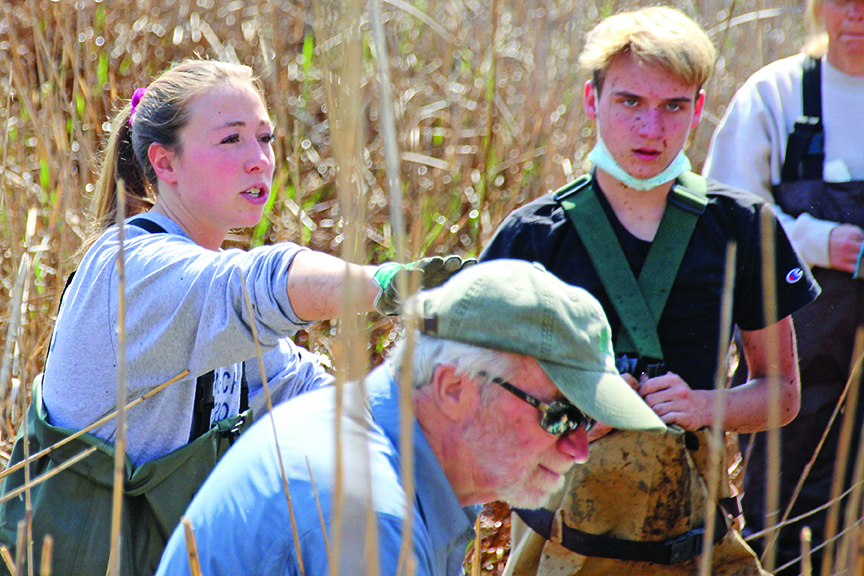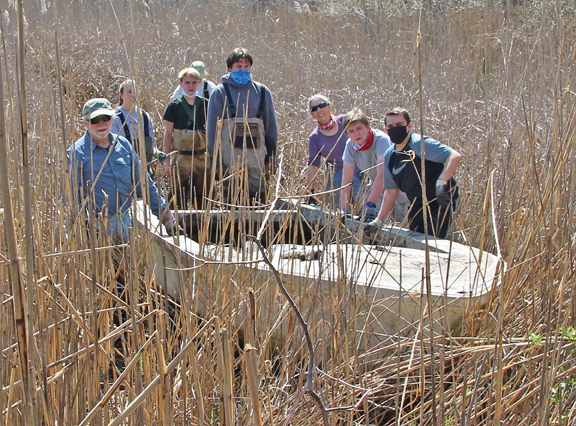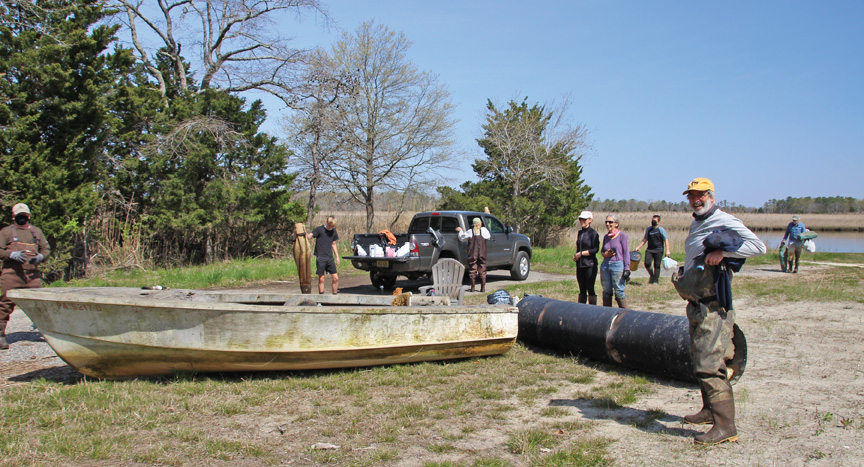Project culmination of Brooke Handley’s internship with the GEH River Council
By CRAIG D. SCHENCK/Sentinel staff
TUCKAHOE — “It was really gross and smelly,” Brooke Handley said of the effort she coordinated to remove a derelict boat from Mosquito Landing on the Tuckahoe River.
The 2017 Ocean City High School graduate took on the project April 24 as the culmination of her internship with the Great Egg Harbor River Council (GEHRC), which is made up of 12 municipalities and the nonprofit Great Egg Harbor Watershed Association that jointly agreed to protect the river in perpetuity.
The 21-year-old resident of the Tuckahoe section of Upper Township is about to graduate from Stockton University with a bachelor’s degree in environmental science.

“The debris in our waterways is becoming an issue that we would like to educate the residents and leaders of our community about to remediate the issue and prevent new items from making their way into our rivers and bays,” Handley said.
She said she learned by going to the watershed that the larger items are mostly coming from waterfront properties.
Fred Akers, administrator of the GEHRC — a position funded by the federal government — said Handley’s project is just a small part of an enormous task.
“Last year I was alerted to an issue I really hadn’t paid much attention to, and it’s a growing issue, and that is the proliferation of marine debris — large debris items that are being collected on the marsh,” Akers said.
He said he wanted to create an inventory of the items and an interactive map using GPS coordinates to identify their location and plan for their removal.
“I went out and looked around and I found a couple of boats, half a dozen pieces of dock and some other things,” Akers said.
He was about to start looking for an employee to take on the project when Upper Township Beach Patrol Chief Bill Handley, a member of the GEHRC, told him his daughter was seeking an internship.
“I was thinking, ‘Oh, man,’” he said.

Akers said Handley started using Google Earth Pro to identify large items in the watershed and map them for future removal. It was during that process that Handley found the boat that eventually was removed.
“That one was accessible by land and small enough that we determined that if we had a group of ambitious individuals that we could drag that thing out of the phragmites marsh,” Akers said, adding that the marine debris inventory now has about 24 items on it, including four boats, about 10 pieces of dock and a refrigerator.
Handley coordinated most of the details, reaching out to Mike Sharp, scoutmaster of Boy Scout Troop 79 in Upper Township, for some help and arranging for the Upper Township Department of Public Works to pick the vessel up from the dock and dispose of it. She said eight to 10 Scouts and five or six adults took part in removing the vessel.
“It takes a lot of people and a lot of help,” she said. “It really requires a lot of manpower.”

An early interest
Brooke Handley, who is entering her sixth year on the UTBP, developed a love for nature and the seashore environment at a young age.
She was on the crew team at OCHS, part of a lightweight eight, and said her favorite part of being on the patrol is being able to row the life boats.
Handley said growing up at the shore has provided her with a “greater appreciation for nature and wetlands and the ocean.”
She said her interest in environmental science began in high school, where she took AP classes on the subject.
“I tried to take classes that had to do with the environment and where I got to go outside for class,” she said.
Handley said she had participated in cleanups in the past but had never coordinated an effort herself such as the April 24 event.
Starting at 9:30 a.m., about 15 people gathered to remove the 16-foot skiff.
Handley said it was evident the boat had been there for a long time because it was filled with mud and vegetation. Looking back on aerial images, she discovered the boat had been there since about 2007.
“There was a long time for the vegetation to really move into the boat,” Handley said.
She said root mats had formed and had to be broken up with shovels and dug out before an attempt could be made at removing the boat.
The group pushed and pulled to get the boat through the phragmites and uplands of the river. They stopped often for breaks, calf-deep in river mud, but continued their effort until the boat was finally close enough to shore to tie a rope to the end and use a pickup truck to pull it the rest of the way.
“It really didn’t take that long because we had a lot of people helping,” she said.
Akers said just as important as identifying and removing the items is figuring out a way to prevent the problem from occurring. He said it is illegal to abandon a vessel, and if the owner can be identified he or she could be fined. But he said he is looking for a stronger deterrent.
“I’m doing research on that aspect of the program right now,” he said. “It’s a big, big effort.”
Akers said Handley’s project was one step forward.
“That was a big event because we removed one of these marine debris items and it was totally a volunteer effort,” he said, noting most of the other items are either too large or too difficult to access and remove.

Handley said when she first got started on the project she was thinking it would involve mostly trash and other small items.
“This stuff is huge,” she said, noting that aerial images fail to reflect the actual size of items.
She also noted the difficulty in dealing with the red tape, such as trying to identify the owner of the land where the items are located and determining who owns them.
“Overall I learned it’s not a simple task to get rid of this stuff and that’s why it’s really important for us to be aware of it and educate people on how to properly dispose of their items and why they shouldn’t just set things free into the watershed,” Handley said.
With graduation looming, Handley now is applying for jobs but ultimately plans to get a master’s degree.


